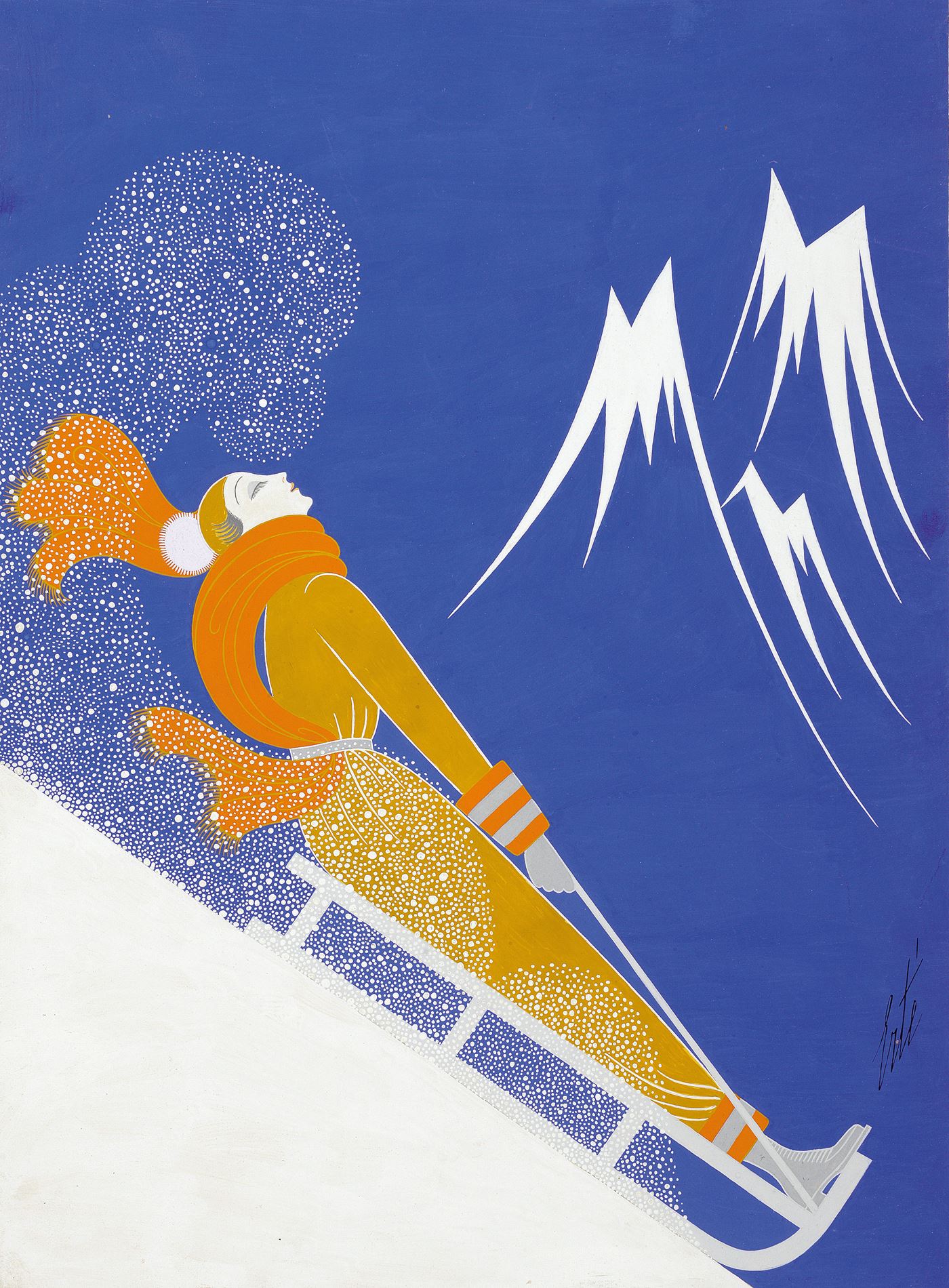
Romain de Tirtoff ERTÉ (1892 1990)N/A
Romain de Tirtoff (Роман Тыртов) Romain de Tirtoff (23 November 1892 - 21 April 1990) was a Russian-born French artist and designer known by the pseudonym Erté, from the French pronunciation of his initials (pronounced [ɛʁ.te]). He was a diversely talented 20th-century artist and designer who flourished in an array of fields.
.jpg)
Romain De Tirtoff 'Erté' (Russian/French, 18921990) , Final Christie's
Erté was born Romain de Tirtoff in St. Petersburg, Russia on November 23rd, 1892. The only son of an admiral in the Imperial Fleet, he was raised amidst Russia's social elite. As a young boy, Romain worshipped his mother and was educated at home until the age of twelve, spending much of the time in the company of elega

ERTE [ROMAIN DE TIRTOFF] (RUSSIANFRENCH 18921990) — Fine & Decorative Art Auction Shapiro
Romain de Tirtoff , known by the pseudonym Erté , was a Russian-born French artist and designer. He was a 20th-century artist and designer in an array of fields, including fashion, jewellery, graphic arts, costume, and set design for film, theatre, and opera, and interior decor.
.jpg)
Romain De Tirtoff 'Erté' (Russian/French, 18921990) , Elle ou Lui Christie's
Born Romain de Tirtoff in St. Petersburg, Russia in 1892, Erté broke free from the conventions of his aristocratic family and moved to Paris in 1910 to follow his ambitions as an artist. After a couple of years, his breakthrough, and arguably his biggest influence, was brief collaboration with famed Parisian couturier Paul Poiret , who renamed.
.jpg?mode=max)
Romain De Tirtoff 'Erté' (Russian/French, 18921990)
Born as Romain de Tirtoff on November 23, 1892, in St. Petersburg, Russia, the artist who would later be known as Erté displayed an innate creative spark from a young age. Growing up in a culturally rich environment, he was surrounded by art, music, and theater, as his father was a respected Russian admiral and his mother a talented amateur.
.jpg)
Romain De Tirtoff 'Erté' (Russian/French, 18921990) , L'Indienne Christie's
Russian-born French artist and designer Romain de Tirtoff (1892 - 1990), known by the pseudonym Erté, France, February 1968. Photograph: Express/Getty Images. From the Guardian archive Fashion.

Стиль — это я!, фото № 2Стиль — это я!, фото № 1 Эрте Alphonse Mucha, Old Photos, Vintage Photos
Designer: Erté (Romain de Tirtoff) (French (born Russia), St. Petersburg 1892-1990 Paris) Date: 1931. Medium: Gouache, metallic paint on paper. Dimensions: 16 x 18 1/2 in. (40.6 x 47.0 cm) Classification: Drawings. Credit Line: Gift of Robert Gifford Berry and Christiane Laus Berry, 2000. Accession Number: 2000.428.

Notes From A Superfluous Man Cartoons magazine, Fantasy games, Romain de tirtoff
Romain de Tirtoff (23 November 1892 - 21 April 1990), known by the pseudonym Erté (from the French pronunciation of his initials: [ɛʁte]), was a Russian-born French artist and designer.He was a 20th-century artist and designer in an array of fields, including fashion, jewellery, graphic arts, costume, and set design for film, theatre, and opera, and interior decor.

Famous Art Deco Artists List of All Art Deco Painters and Sculptors
Fashion, architecture, theatre, and art. In 2020, the study and intrigue of these cultural foundations can be traced back to one man: Romain de Tirtoff, better known as Erté. Until recent history, the very notion of leisure and non-utilitarian possessions were only reserved for the privileged.
.jpg)
Romain De Tirtoff 'Erté' (Russian/French, 18921990) , Rasputine Christie's
Romain de Tirtoff, who called himself Erté, was born in St. Petersburg and moved to Paris in 1912 to work in fashion. He briefly collaborated with couturier Paul Poiret, and in 1915 he signed a.
.jpg?mode=max)
Romain De Tirtoff 'Erté' (Russian/French, 18921990)
"Madame, I assure you that I am Erté," replied the elegant artist, whose real name was Romain de Tirtoff - hence the French pronunciation of his initials "R" and "T". Romaine de Tirtoff (originally Roman Tyrtov), or Erté, c. 1920, when he was making costumes and film sets for the Metro-Goldwyn-Mayer film studio
.jpg)
Romain De Tirtoff 'Erté' (Russian/French, 18921990) , Le Canards Christie's
Erté (Romain de Tirtoff) (French [born Russia], 1892-1990). "La Mer Blanche": Costume Design for Les Mers , George White's Scandals , New York , 1923. Gouache silver metallic paint on cardboard; 13 3/8 x 18 1/2 in. (34 x 47 cm).

Romain De Tirtoff ‘Erté’ (18921990) , Femme aux plumes Christie's
Romain de Tirtoff (1892-1990) Erte's real name is Romain Petrovich Tirtoff. The phenomenal Erte - one of the "pillars" of the Art Deco style, is an almost mystical figure. Born in the 19th century in Russia and leaving for a dreamland at the end of the 20th century in France, he lived for almost a century, and his legendary pseudonym is.
.jpg?mode=max)
Romain De Tirtoff 'Erté' (18921990)
Erté's signature. Romain de Tirtoff (23 November 1892 - 21 April 1990), known by the pseudonym Erté (from the French pronunciation of his initials: ), was a Russian-born French artist and designer. He was a 20th-century artist and designer in an array of fields, including fashion, jewellery, graphic arts, costume, and set design for film, theatre, and opera, and interior decor.

Erté (Romain de Tirtoff, 18921990), a Russianborn French artist and designer Romain De Tirtoff
Erté was the pseudonym of Russian-born Frenchman, Romain de Tirtoff (1892-1990), an artist, illustrator and designer whose lavish Art Deco creations enjoyed a wide range of applications - from fashion and magazine design, to sets and costumes for theatre, opera and film. Costume for Mata Hari, 1913. Design for Le Minaret - the first.

ErteArtistDesignerAlways with a sketch book in his hands Romain de tirtoff, Art deco
To create unique footwear designs, the businessman attracted various well-known designers including Erté (Romain de Tirtoff, French, born Russia, 1892-1990, see designs nearby), Roger Vivier (French, 1913-1998) and Herbert Levine (American, 1916-1991). Another important contributor was Steven Arpad (French, 1904-1999), who designed an.